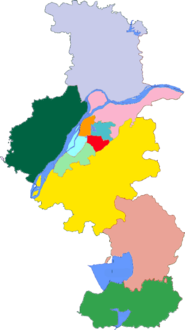Xuanwu District, Nanjing
|
Xuanwu 玄武区 |
|||||||||||||||||||||||||||||||||
|---|---|---|---|---|---|---|---|---|---|---|---|---|---|---|---|---|---|---|---|---|---|---|---|---|---|---|---|---|---|---|---|---|---|
| District | |||||||||||||||||||||||||||||||||
| Location in Jiangsu | |||||||||||||||||||||||||||||||||
| Coordinates: 32°03′36″N 118°50′54″E / 32.0601°N 118.8483°ECoordinates: 32°03′36″N 118°50′54″E / 32.0601°N 118.8483°E | |||||||||||||||||||||||||||||||||
| Country | People's Republic of China | ||||||||||||||||||||||||||||||||
| Province | Jiangsu | ||||||||||||||||||||||||||||||||
| Sub-provincial city | Nanjing | ||||||||||||||||||||||||||||||||
| Area | |||||||||||||||||||||||||||||||||
| • Total | 81 km2 (31 sq mi) | ||||||||||||||||||||||||||||||||
| Population (2011) | |||||||||||||||||||||||||||||||||
| • Total | 634,000 | ||||||||||||||||||||||||||||||||
| • Density | 7,800/km2 (20,000/sq mi) | ||||||||||||||||||||||||||||||||
| Time zone | China Standard (UTC+8) | ||||||||||||||||||||||||||||||||
| Nanjing district map |
|
||||||||||||||||||||||||||||||||
Xuanwu District (simplified Chinese: 玄武区; traditional Chinese: 玄武區; pinyin: Xuánwǔ qū) is one of 11 districts of Nanjing, the capital of Jiangsu province, China. Xuanwu District is an urban centre located in the north-eastern part of Nanjing. It is the site of the Nanjing Municipal Government.
The main industries in the district are the leisure and tourism, information technology, retail and services. Its economy is primarily based upon the delivery of services. Industry zones include the Changjiang Road Cultural Area, Xinjiekou Central Economic Area, and Xuzhuang Software Industry Base. The district has attracted multi-national corporations, such as 3M, American Express, Siemens, Hyundai, Samsung, NYK Line, and Cathay Life Insurance.
There are more than 40 colleges, universities and research institutes in the district, including Southeast University, Nanjing University of Science and Technology, Nanjing Agricultural University, Nanjing Forestry University and Jiangsu Academy of Agricultural Sciences. There are about 35 academics from the Chinese Academy of Engineering and Chinese Academy of Sciences there, which represents about 50% of the academics from those academies in Jiangsu Province.
...
Wikipedia


